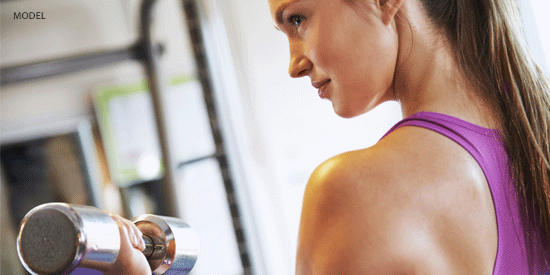One of the most common questions I hear from patients considering breast augmentation is, “How long before I can exercise after my surgery?” It’s a great question, and the answer is slightly different for each of my patients in the Louisville and Lexington area depending on her body. In general, all patients should rest after their surgery, but they’re not restricted from moving around entirely.
In this post, you’ll learn how breast augmentation and exercise should and shouldn’t be mixed. Plus, I’ll share a timeline for exercising after your surgery so you can make the most of your recovery, without letting your hard work at the gym go to waste.
How They Do Mix
Breast augmentation, like other forms of surgery, requires a few days of rest and relaxation so that your body can kick-start the healing process. Moderate movement can actually be helpful as it keeps a patient’s blood circulating, boosts energy levels, and promotes the body’s healing process. So yes, breast augmentation and exercise can mix — to an extent.
It’s important that patients follow their doctor’s orders for recovery carefully and get approval before beginning any types of exercise.
Here is a rough timeline for working out that you may find helpful to reference:
- During the few days after your surgery: You can begin to move around the house or even walk down the block if you’re feeling up to it.
- Between 1 and 3 weeks after surgery: You can start going for longer, more brisk walks and get used to the way your new contours feel. Refrain from any cardio or lifting at this time, and try to keep movement to the lower portion of your body.
- 3 weeks after surgery: You can begin to return to the gym, again starting slowly. Lift lighter weights and perform cardio activities that don’t involve you lowering your chest below your waist.
- 1 month after surgery: You can build back up to the level of fitness you were at before surgery and find the right moves to accentuate your newly enhanced contours.
The most important thing to remember at all times is to listen to your body. Do not perform any activity that causes pain, discomfort, or dizziness. Remember to consult with your surgeon before beginning any workout regimen.
How They Don’t Mix
While the appropriate amount of exercise after plastic surgery can be a good thing, too much exertion can have negative effects. For one, the pain medication you have been prescribed does not pair well with workouts. It can make you dizzy and weak, and even more prone to injury.
Additionally, too much movement can increase the amount of time your implants need to settle. Once implants have been placed, the tissue around them needs to both stretch slightly to accommodate the new volume and adhere to the implants to secure them comfortably within your body. Moving your arms around excessively and putting pressure on that area can delay this from happening.
Finally, the extra movement is not good for incisions. It’s best to keep tension on your skin as minimal as possible so that your incisions heal quickly to fine lines that grow fainter over time. Be mindful of your movements to help keep your healing process on track, and you’ll be back in the gym soon.
If you’re interested in breast augmentation in the Louisville or Lexington area, I encourage you to visit the breast augmentation section of our blog. Dr. Mizuguchi and I discuss a variety of topics related to the procedure, including implant types, recovery tips, myths, and more.


Leave a Reply